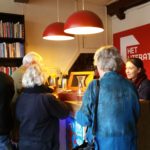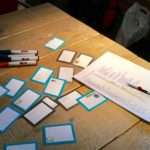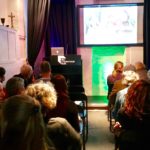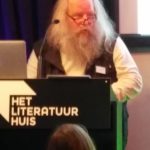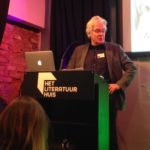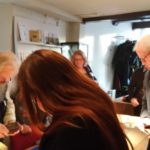40 years of the Lewis Carroll Society: a trip down memory lane
By Casper Schuckink Kool
In 1975, ‘Alice in Wonderland’ was 110 years old, whereas I was 30 years old. The internet was yet to be invented, as was the smartphone, which can accomplish more than those expensive office computers we used to have, and where sheets still had to be printed with a mimeograph.
Since my early childhood, I read everything I could get my hands on. Alice in Wonderland, in its translation by Reedijk and Kossmann, was one of my favourites. When, as a teenager, I found not only the original English text but also a Latin translation at bookshop De Slegte, I decided to start collecting Alice-editions.
Over the next decade, my collection grew steadily. On a bookhunt in London, I discovered so much more: biographies, the Snark, photography, logic, parodies and more. I joined the British Lewis Carroll Society, which had been established in 1969, as well as the Lewis Carroll Society of North America (1974), and even attempted to produce a Snark translation which would be worthy of the original – the Hunting of the Snark had not yet been translated into Dutch at that time.
I very much wanted to exchange ideas with people who had similar interests. So how should one go about this, in the Seventies? Well, you placed an advertisement in weekly news magazine Vrij Nederland! The text ran along these lines: Bellman requires crew for hunt of the Snark. Are you, as I am, fascinated by the life and works of Charles L. Dodgson aka Lewis Carroll, author of, amongst others, Alice in Wonderland, please contact …
I received dozens of reactions. I invited those who had written to me to come to Amsterdam. And there, on the 16th of January, 1976 the Lewis Carroll Society was born. It was an informal bunch, without legal stature, nor were there a board or any mandatory contributions, statutes or regulations. Meetings would take place at members’ homes, even if they happened to live 150 miles away in Groningen. Although our ‘members’ were mostly students and recent graduates, we also had more senior participants, two out of three members were men. There were collectors, translators, mathematicians – and so, numerous disciplines were represented.
We decided to publish a magazine, titled “Wauwelwok”. The first issue came out in October 1977. Subsequently, the following issues, focusing on specific themes, appeared: the Boojum Issue [1978]; Lewis Carroll Calendar 1981 [late 1980], and finally, “Catalogue of 100+ Dutch Alice in Wonderland-editions” [1982].
And so, in its first seven years, the LCG produced five unique magazines, organised innumerable living room meetings and hosted interesting guests speakers such as the Schaeffers, an American married couple specialised in Alice film adapations. We even made it into the national press after a conflict with translator Eelke de Jong.
And then things got quiet. The founding members got caught up in other obligations, such as family and career, and hardly any new members (who now had to pay a yearly contribution of 15 guilders) joined us. And so, the LCG dissolved, softly but suddenly, into nothingness. Formally, it was never disbanded, perhaps it had been hiding behind a cloud all of this time.
That now, in 2016 and 40 years after its inception, there is an effort to kiss the sleeping Society awake, can all be attributed to the initiative of Bas Savenije. I support this undertaking wholeheartedly and to the best of my ability. I do realise that times have changed, and that the LCG today will be different from the one I knew. Still, when its new members will be as enthusiastic as (we were) in the seventies, there are some wonderful times ahead.
My Fascination with Lewis Carroll: That’s logic
By Bas Savenije
The first time I encountered Alice in Wonderland was as a child. Honesty commands me to confess that the time, place and context of this encounter are no longer clear in my mind. But when I renewed my acquaintance, which happened when I read to my children and as we watched those inescapable Disney-films together, I felt a resounding sense of familiarity.
In the Nineties, I stumbled upon a first edition of Alice for a rather low price at a book stall on the streets of Tallinn. Without hesitation, I bought the well-thumbed volume. Not long afterwards, I visited Poland, and I could not resist the temptation to search for a Polish version. The genie was out of the bottle and here I am today, an avid collector of Alice-editions.
Whilst I was still director of the Koninklijke Bibliotheek (the National Library of the Netherlands), my collecting was still haphazard, but since my retirement, I have been going about things in a much more systematic way. Initially, I was mostly interested in the way in which illustrators interpreted Lewis Carroll’s creations over the years. But soon, I was not only fascinated by his work, but also by Carroll as a person, his life, ideas and beliefs.
As long as I can remember I adored paradoxes, wordplay and riddles, which all feature copiously in Carroll’s work. I am also gripped by his sense of humour. As I learned more about Lewis Carroll himself, it became apparent why this was the case. Lewis Carroll was a mathematician who had a particular interest in Logic. After graduating from high school, I studied Mathematics for two years and –after a short hiatus during which I was drafted into military service– I subsequently studied Philosophy. My original interest in Social Philosophy soon had to yield to my new fascination for Logic. Eventually, I also returned to my Mathematical studies and I completed my studies specialising in a combination of Logic, Mathematics and Linguistics.
And now, I am studying the history of Logic so as to appreciate Carroll’s contributions to the field. But I am also very interested in the synergies between Logic and Language, which are also an important and recurring aspect of his works.
In Lewis Carroll’s contributions to the field of Logic, the reductio ad absurdum plays an important role. For years, it has also been my own favourite argumentative approach. This tension between absurdity and logic features prominently in Carroll’s writing.
To quote Tweedledee: “If it was so, it might be; and if it were so, it would be; but as it isn’t, it ain’t. That’s logic.”
I am very much looking forward to share and exchange ideas and thoughts with others. The Lewis Carroll Society is an excellent platform to do so.
Symposium “Alice in Verwonderland”
On 20 January 2017 the revival of the society has been celebrated with a festive meeting with 35 participants in “Het Literatuurhuis”, Utrecht.
The programme (in Dutch):
- Alice in Verwonderland | Casper Schuckink Kool
- Wonderlijke wetenswaardigheden in een wiskundig wonderland | Henri Ruizenaar
- Alice in adaptatie: Manga Wonderland | Laurence Herfs
After these presentations the future of the Dutch Lewis Carroll Society was discussed.
The meeting was concluded informally with a possibility to exchange or buy editions of Lewis Carroll’s works.
A photographic impression:
Second Symposium on 12 January 2018
On 12 January 2018 the second symposium of the Lewis Carroll Genootschap took place in the KB, National Library of The Netherlands in The Hague.
The program (in Dutch)
- “Nieuw Wonderland” by illustrator Floor Rieder
- “Alles in Wonderland: kan onze taal de werkelijkheid beschrijven?” by Fedde Benedictus
- Presentation of the new publications of the Lewis Carroll Genootschap.


